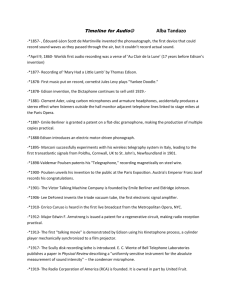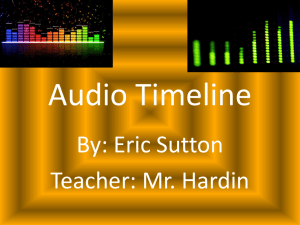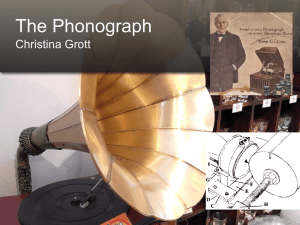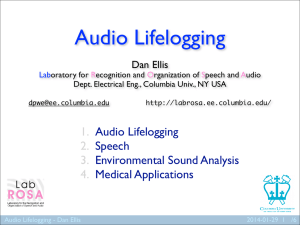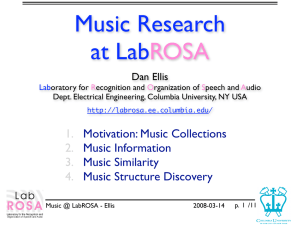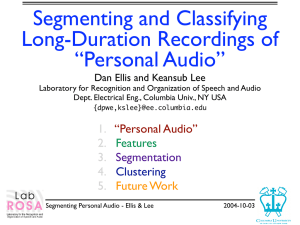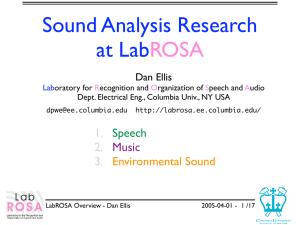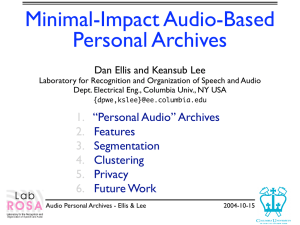Slide 1 - knomi.net
advertisement
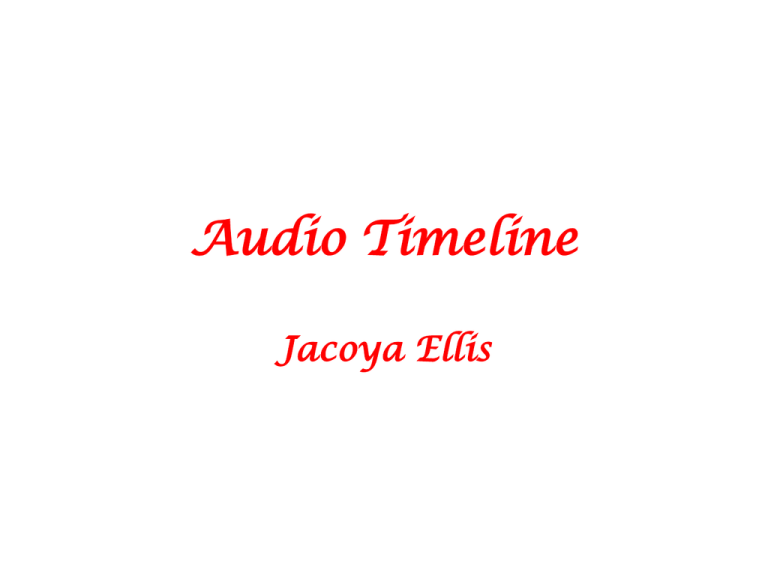
Audio Timeline Jacoya Ellis Audio Timeline Jacoya Ellis 1877 • Thomas Alva Edison, working in his lab, succeeds in recovering Mary's Little Lamb from a strip of tinfoil wrapped around a spinning cylinder. • He demonstrates his invention in the offices of Scientific American, and the phonograph is born. 1878 • The first music is put on record: cornetist Jules Levy plays "Yankee Doodle." 1881 • Clement Ader, using carbon microphones and armature headphones, accidentally produces a stereo effect when listeners outside the hall monitor adjacent telephone lines linked to stage mikes at the Paris Opera 1887 • Emile Berliner is granted a patent on a flat-disc gramophone, making the production of multiple copies practical 1888 • Edison introduces an electric motor-driven phonograph 1895 • Marconi successfully experiments with his wireless telegraphy system in Italy, leading to the first transatlantic signals from Poldhu, Cornwall, UK to St. John's, Newfoundland in 1901. 1898 • Valdemar Poulsen patents his "Telegraphone," recording magnetically on steel wire 1900 • Poulsen unveils his invention to the public at the Paris Exposition. Austria's Emperor Franz Josef records his congratulations. • Boston's Symphony Hall opens with the benefit of Wallace Clement Sabine's acoustical advice 1901 • The Victor Talking Machine Company is founded by Emile Berliner and Eldridge Johnson. • Experimental optical recordings are made on motion picture film. 1906 • Lee DeForest invents the triode vacuum tube, the first electronic signal amplifier 1910 • Enrico Caruso is heard in the first live broadcast from the Metropolitan Opera, NYC 1912 • Major Edwin F. Armstrong is issued a patent for a regenerative circuit, making radio reception practical. 1913 • The first "talking movie" is demonstrated by Edison using his Kinetophone process, a cylinder player mechanically synchronized to a film projector. 1967 • Richard C. Heyser devises the "TDS" (Time Delay Spectrometry) acoustical measurement scheme, which paves the way for the revolutionary "TEF" (Time Energy Frequency) technology. • Altec-Lansing introduces "Acousta-Voicing," a concept of room equalization utilizing variable multiband filters. • Elektra releases the first electronic music recording: Morton Subotnick's Silver Apples of the Moon. • The Monterey International Pop Festival becomes the first large rock music festival. • The Broadway musical Hair opens with a high-powered sound system. • The first operational amplifiers are used in professional audio equipment, notably as summing devices for multichannel consoles. 1986 • The first digital consoles appear. • R-DAT recorders are introduced in Japan. • Dr. Gunther Theile describes a novel stereo "sphere microphone." 1998 • The Winter Olympics open with a performance of Beethoven's "Ode to Joy," played and sung by synchronizing live audio feeds from five continents with an orchestra and conductor at the Olympic stadium in Nagano, Japan, using satellite and ISDN technology. • Golden Anniversary celebration held in New York on March 11, the exact date of the first AES meeting in 1948, with ten of the original members present. • MP-3 players for downloaded Internet audio appear. http://www.aes.org/aeshc/ docs/audio.history.timelin e.html Jacoya Ellis Is Born What a wonderful blessing…
